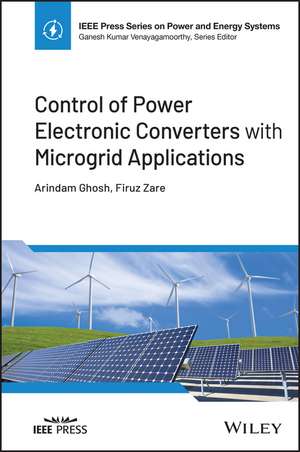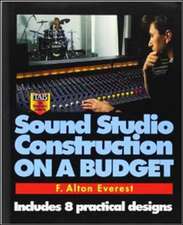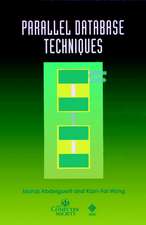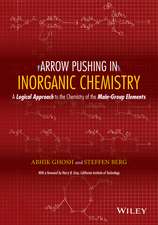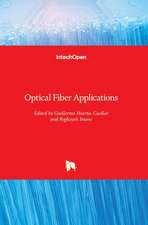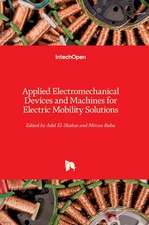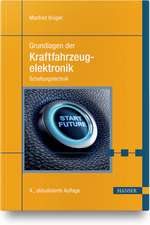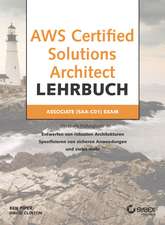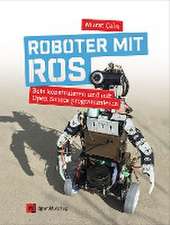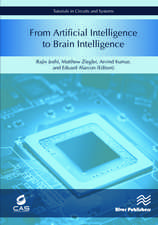Control of Power Electronic Converters with Microgrid Applications: IEEE Press Series on Power and Energy Systems
Autor A Ghoshen Limba Engleză Hardback – 14 sep 2022
Din seria IEEE Press Series on Power and Energy Systems
- 24%
 Preț: 652.67 lei
Preț: 652.67 lei - 24%
 Preț: 609.53 lei
Preț: 609.53 lei - 19%
 Preț: 521.21 lei
Preț: 521.21 lei - 24%
 Preț: 784.16 lei
Preț: 784.16 lei - 24%
 Preț: 1053.86 lei
Preț: 1053.86 lei - 9%
 Preț: 809.68 lei
Preț: 809.68 lei - 9%
 Preț: 831.27 lei
Preț: 831.27 lei - 9%
 Preț: 888.01 lei
Preț: 888.01 lei - 9%
 Preț: 950.76 lei
Preț: 950.76 lei - 9%
 Preț: 869.23 lei
Preț: 869.23 lei - 9%
 Preț: 1196.97 lei
Preț: 1196.97 lei - 9%
 Preț: 849.90 lei
Preț: 849.90 lei - 9%
 Preț: 1015.99 lei
Preț: 1015.99 lei - 8%
 Preț: 654.00 lei
Preț: 654.00 lei - 8%
 Preț: 633.18 lei
Preț: 633.18 lei - 9%
 Preț: 823.81 lei
Preț: 823.81 lei - 9%
 Preț: 759.78 lei
Preț: 759.78 lei - 9%
 Preț: 855.00 lei
Preț: 855.00 lei - 9%
 Preț: 972.84 lei
Preț: 972.84 lei - 9%
 Preț: 1023.14 lei
Preț: 1023.14 lei - 9%
 Preț: 758.19 lei
Preț: 758.19 lei - 9%
 Preț: 946.67 lei
Preț: 946.67 lei - 9%
 Preț: 1002.09 lei
Preț: 1002.09 lei - 8%
 Preț: 648.70 lei
Preț: 648.70 lei - 9%
 Preț: 1077.09 lei
Preț: 1077.09 lei - 9%
 Preț: 1118.73 lei
Preț: 1118.73 lei - 9%
 Preț: 1017.31 lei
Preț: 1017.31 lei - 9%
 Preț: 814.32 lei
Preț: 814.32 lei - 9%
 Preț: 830.83 lei
Preț: 830.83 lei - 9%
 Preț: 834.87 lei
Preț: 834.87 lei - 9%
 Preț: 893.28 lei
Preț: 893.28 lei - 9%
 Preț: 929.27 lei
Preț: 929.27 lei - 9%
 Preț: 1301.39 lei
Preț: 1301.39 lei - 9%
 Preț: 855.70 lei
Preț: 855.70 lei - 9%
 Preț: 781.26 lei
Preț: 781.26 lei - 9%
 Preț: 1009.20 lei
Preț: 1009.20 lei - 9%
 Preț: 886.41 lei
Preț: 886.41 lei - 9%
 Preț: 730.17 lei
Preț: 730.17 lei - 9%
 Preț: 822.19 lei
Preț: 822.19 lei - 9%
 Preț: 963.72 lei
Preț: 963.72 lei - 9%
 Preț: 726.13 lei
Preț: 726.13 lei - 9%
 Preț: 953.44 lei
Preț: 953.44 lei - 9%
 Preț: 851.69 lei
Preț: 851.69 lei - 9%
 Preț: 1200.59 lei
Preț: 1200.59 lei - 9%
 Preț: 947.55 lei
Preț: 947.55 lei - 9%
 Preț: 777.30 lei
Preț: 777.30 lei - 9%
 Preț: 715.62 lei
Preț: 715.62 lei - 9%
 Preț: 786.64 lei
Preț: 786.64 lei - 9%
 Preț: 962.47 lei
Preț: 962.47 lei - 9%
 Preț: 810.41 lei
Preț: 810.41 lei
Preț: 763.95 lei
Preț vechi: 839.51 lei
-9% Nou
Puncte Express: 1146
Preț estimativ în valută:
146.18€ • 153.03$ • 120.96£
146.18€ • 153.03$ • 120.96£
Carte tipărită la comandă
Livrare economică 07-21 aprilie
Preluare comenzi: 021 569.72.76
Specificații
ISBN-13: 9781119815433
ISBN-10: 1119815436
Pagini: 544
Dimensiuni: 152 x 229 x 30 mm
Greutate: 0.88 kg
Editura: Wiley
Seria IEEE Press Series on Power and Energy Systems
Locul publicării:Hoboken, United States
ISBN-10: 1119815436
Pagini: 544
Dimensiuni: 152 x 229 x 30 mm
Greutate: 0.88 kg
Editura: Wiley
Seria IEEE Press Series on Power and Energy Systems
Locul publicării:Hoboken, United States
Cuprins
Author Biographies xv
Preface xvii
Acknowledgments xxi
1 Introduction 1
1.1 Introduction to Power Electronics 4
1.2 Power Converter Modes of Operation 7
1.3 Power Converter Topologies 9
1.4 Harmonics and Filters 10
1.5 Power Converter Operating Conditions, Modelling, and Control 12
1.6 Control of Power Electronic Systems 14
1.6.1 Open-loop Versus Closed-loop Control 14
1.6.2 Nonlinear Systems 16
1.6.3 Piecewise Linear Systems 17
1.7 Power Distribution Systems 18
1.8 Concluding Remarks 20
References 20
2 Analysis of AC Signals 23
2.1 Symmetrical Components 24
2.1.1 Voltage Unbalanced Factor (VUF) 25
2.1.2 Real and Reactive Power 26
2.2 Instantaneous Symmetrical Components 27
2.2.1 Estimating Symmetrical Components from Instantaneous Measurements 29
2.2.2 Instantaneous Real and Reactive Power 34
2.3 Harmonics 37
2.4 Clarke and Park Transforms 39
2.4.1 Clarke Transform 39
2.4.2 Park Transform 40
2.4.3 Real and Reactive Power 41
2.4.4 Analyzing a Three-phase Circuit 43
2.4.5 Relation Between Clarke and Park Transforms 45
2.5 Phase Locked Loop (PLL) 46
2.5.1 Three-phase PLL System 47
2.5.2 PLL for Unbalanced System 50
2.5.3 Frequency Estimation of Balanced Signal Using alphaß Components 52
2.6 Concluding Remarks 53
Problems 54
Notes and References 56
3 Review of SISO Control Systems 59
3.1 Transfer Function and Time Response 60
3.1.1 Steady State Error and DC Gain 60
3.1.2 System Damping and Stability 62
3.1.3 Shaping a Second-order Response 63
3.1.4 Step Response of First- and Higher-order Systems 65
3.2 Routh-Hurwitz's Stability Test 66
3.3 Root Locus 69
3.3.1 Number of Branches and Terminal Points 70
3.3.2 Real Axis Locus 71
3.3.3 Breakaway and Break-in Points 73
3.4 PID Control 76
3.4.1 PI Controller 77
3.4.2 PD Controller 78
3.4.3 Tuning of PID Controllers 81
3.5 Frequency Response Methods 83
3.5.1 Bode Plot 85
3.5.2 Nyquist (Polar) Plot 89
3.5.3 Nyquist Stability Criterion 91
3.6 Relative Stability 95
3.6.1 Phase and Gain Margins 95
3.6.2 Bandwidth 101
3.7 Compensator Design 104
3.7.1 Lead Compensator 104
3.7.2 Lag Compensator 108
3.7.3 Lead-lag Compensator 108
3.8 Discrete-time Control 110
3.8.1 Discrete-time Representation 110
3.8.2 The z-transform 111
3.8.3 Transformation from Continuous Time to Discrete Time 112
3.8.4 Mapping s-Plane into z-Plane 112
3.8.5 Difference Equation and Transfer Function 113
3.8.6 Digital PID Control 115
3.9 Concluding Remarks 115
Problems 116
Notes and References 120
4 Power Electronic Control Design Challenges 123
4.1 Analysis of Buck Converter 123
4.1.1 Designing a Buck Converter 126
4.1.2 The Need for a Controller 128
4.1.3 Dynamic State of a Power Converter 133
4.1.4 Averaging Method 133
4.1.5 Small Signal Model of Buck Converter 135
4.1.6 Transfer Function of Buck Converter 136
4.1.7 Control of Buck Converter 136
4.2 Transfer Function of Boost Converter 140
4.2.1 Control of Boost Converter 141
4.2.2 Two-loop Control of Boost Converter 144
4.2.3 Some Practical Issues 150
4.3 Concluding Remarks 151
Problems 151
Notes and References 152
5 State Space Analysis and Design 153
5.1 State Space Representation of Linear Systems 154
5.1.1 Continuous-time Systems 154
5.1.2 Discrete-time Systems 155
5.2 Solution of State Equation of a Continuous-time System 156
5.2.1 State Transition Matrix 156
5.2.2 Properties of State Transition Matrix 158
5.2.3 State Transition Equation 159
5.3 Solution of State Equation of a Discrete-time System 160
5.3.1 State Transition Matrix 161
5.3.2 Computation of State Transition Matrix 161
5.3.3 Discretization of a Continuous-time System 162
5.4 Relation Between State Space Form and Transfer Function 164
5.4.1 Continuous-time System 164
5.4.2 Discrete-time System 166
5.5 Eigenvalues and Eigenvectors 167
5.5.1 Eigenvalues 167
5.5.2 Eigenvectors 168
5.6 Diagonalization of a Matrix Using Similarity Transform 170
5.6.1 Matrix with Distinct Eigenvalues 170
5.6.2 Matrix with Repeated Eigenvalues 173
5.7 Controllability of LTI Systems 174
5.7.1 Implication of Cayley-Hamilton Theorem 176
5.7.2 Controllability Test Condition 176
5.8 Observability of LTI Systems 178
5.9 Pole Placement Through State Feedback 180
5.9.1 Pole Placement with Integral Action 183
5.9.2 Linear Quadratic Regulator (LQR) 185
5.9.3 Discrete-time State Feedback with Integral Control 187
5.10 Observer Design (Full Order) 187
5.10.1 Separation Principle 188
5.11 Control of DC-DC Converter 190
5.11.1 Steady State Calculation 192
5.11.2 Linearized Model of a Boost Converter 195
5.11.3 State Feedback Control of a Boost Converter 196
5.12 Concluding Remarks 200
Problems 201
Notes and References 204
6 Discrete-time Control 207
6.1 Minimum Variance (MV) Prediction and Control 208
6.1.1 Discrete-time Models for SISO Systems 208
6.1.2 MV Prediction 209
6.1.3 MV Control Law 212
6.1.4 One-step-ahead Control 214
6.2 Pole Placement Controller 218
6.2.1 Pole Shift Control 222
6.3 Generalized Predictive Control (GPC) 225
6.3.1 Simplified GPC Computation 233
6.4 Adaptive Control 234
6.5 Least-squares Estimation 235
6.5.1 Matrix Inversion Lemma 237
6.5.2 Recursive Least-squares (RLS) Identification 238
6.5.3 Bias and Consistency 242
6.6 Self-tuning Controller 244
6.6.1 MV Self-tuning Control 244
6.6.2 Pole Shift Self-tuning Control 248
6.6.3 Self-tuning Control of Boost Converter 249
6.7 Concluding Remarks 252
Problems 253
Notes and References 254
7 DC-AC Converter Modulation Techniques 257
7.1 Single-phase Bridge Converter 258
7.1.1 Hysteresis Current Control 259
7.1.2 Bipolar Sinusoidal Pulse Width Modulation (SPWM) 263
7.1.3 Unipolar Sinusoidal Pulse Width Modulation 265
7.2 SPWM of Three-phase Bridge Converter 267
7.3 Space Vector Modulation (SVM) 271
7.3.1 Calculation of Space Vectors 272
7.3.2 Common Mode Voltage 273
7.3.3 Timing Calculations 274
7.3.4 An Alternate Method for Timing Calculations 277
7.3.5 Sequencing of Space Vectors 279
7.4 SPWM with Third Harmonic Injection 282
7.5 Multilevel Converters 285
7.5.1 Diode-clamped Multilevel Converter 290
7.5.2 Switching States of Diode-clamped Multilevel Converters 291
7.5.3 Flying Capacitor Multilevel Converter 295
7.5.4 Cascaded Multilevel Converter 302
7.5.5 Modular Multilevel Converter (MMC) 302
7.5.6 PWM of Multilevel Converters 303
7.6 Concluding Remarks 306
Problems 307
Notes and References 307
8 Control of DC-AC Converters 311
8.1 Filter Structure and Design 311
8.1.1 Filter Design 313
8.1.2 Filter with Passive Damping 315
8.2 State Feedback Based PWM Voltage Control 315
8.2.1 HPF-based Control Design 318
8.2.2 Observer-based Current Estimation 321
8.3 State Feedback Based SVPWM Voltage Control 323
8.4 Sliding Mode Control 324
8.4.1 Sliding Mode Voltage Control 326
8.5 State Feedback Current Control 330
8.6 Output Feedback Current Control 333
8.7 Concluding Remarks 336
Problems 337
Notes and References 338
9 VSC Applications in Custom Power 341
9.1 DSTATCOM in Voltage Control Mode 342
9.1.1 Discrete-time PWM State Feedback Control 346
9.1.2 Discrete-time Output Feedback PWM Control 348
9.1.3 Voltage Control Using Four-leg Converter 351
9.1.4 The Effect of System Frequency 353
9.1.5 Power Factor Correction 357
9.2 Load Compensation 360
9.2.1 Classical Load Compensation Technique 360
9.2.2 Load Compensation Using VSC 363
9.3 Other Custom Power Devices 367
9.4 Concluding Remarks 370
Problems 370
Notes and References 373
10 Microgrids 377
10.1 Operating Modes of a Converter 380
10.2 Grid Forming Converters 381
10.2.1 PI Control in dq-domain 382
10.2.2 State Feedback Control in dq-domain 385
10.3 Grid Feeding Converters 389
10.4 Grid Supporting Converters for Islanded Operation of Microgrids 392
10.4.1 Active and Reactive Over a Feeder 393
10.4.2 Inductive Grid 394
10.4.3 Resistive Grid 398
10.4.4 Consideration of Line Impedances 400
10.4.5 Virtual Impedance 402
10.4.6 Inclusion of Nondispatchable Sources 405
10.4.7 Angle Droop Control 406
10.5 Grid-connected Operation of Microgrid 411
10.6 DC Microgrids 415
10.6.1 P-V Droop Control 417
10.6.2 The Effect of Line Resistances 419
10.6.3 I-V Droop Control 421
10.6.4 DCMG Operation with DC-DC Converters 423
10.7 Integrated AC-DC System 424
10.7.1 Dual Active Bridge (DAB) 425
10.7.2 AC Utility Connected DCMG 429
10.8 Control Hierarchies of Microgrids 430
10.8.1 Primary Control 430
10.8.2 Secondary Control 432
10.8.3 Tertiary Control 433
10.9 Smart Distribution Networks: Networked Microgrids 434
10.9.1 Interconnection of Networked Microgrids 435
10.10 Microgrids in Cluster 439
10.10.1 The Concept of Power Exchange Highway (PEH) 442
10.10.2 Operation of DC Power Exchange Highway (DC-PEH) 444
10.10.3 Overload Detection and Surplus Power Calculation 445
10.10.4 Operation of DC-PEH 447
10.10.5 Dynamic Droop Gain Selection 448
10.11 Concluding Remarks 456
Problems 457
Notes and References 460
11 Harmonics in Electrical and Electronic Systems 465
11.1 Harmonics and Interharmonics 465
11.1.1 High-frequency Harmonics (2-150 kHz) 467
11.1.2 EMI in the Frequency Range of 150 kHz-30 MHz 468
11.1.3 Common Mode and Differential Mode Harmonics and Noises 469
11.1.4 Stiff and Weak Grids 470
11.2 Power Quality Factors and Definitions 471
11.2.1 Harmonic Distortion 471
11.2.2 Power and Displacement Factors 473
11.3 Harmonics Generated by Power Electronics in Power Systems 474
11.3.1 Harmonic Analysis at a Load Side (a Three-phase Inverter) 477
11.3.2 Harmonic Analysis at a Grid Side (a Three-phase Rectifier) 479
11.3.3 Harmonic Analysis at Grid Side (Single-phase Rectifier with and without PF Correction System) 484
11.3.4 Harmonic Analysis at Grid Side (AFE) 488
11.4 Power Quality Regulations and Standards 491
11.4.1 IEEE Standards 491
11.4.2 IEEE 519 491
11.4.3 IEEE 1547 494
11.4.4 IEEE 1662-2008 494
11.4.5 IEEE 1826-2012 495
11.4.6 IEEE 1709-2010 496
11.4.7 IEC Standards 497
11.5 Concluding Remarks 499
Notes and References 499
Index 501
